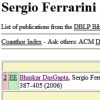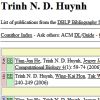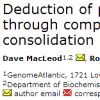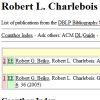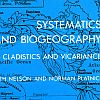| |
 
Leo van Iersel and
Simone Linz. A quadratic kernel for computing the hybridization number of multiple trees. In IPL, Vol. 113:318-323, 2013.
Keywords: explicit network, FPT, from rooted trees, kernelization, minimum number, phylogenetic network, phylogeny, Program Clustistic, Program MaafB, Program PIRN, reconstruction.
Note: http://arxiv.org/abs/1203.4067, poster.
Toggle abstract
"It has recently been shown that the NP-hard problem of calculating the minimum number of hybridization events that is needed to explain a set of rooted binary phylogenetic trees by means of a hybridization network is fixed-parameter tractable if an instance of the problem consists of precisely two such trees. In this paper, we show that this problem remains fixed-parameter tractable for an arbitrarily large set of rooted binary phylogenetic trees. In particular, we present a quadratic kernel. © 2013 Elsevier B.V."
|
|
| |
  
Chris Whidden,
Robert G. Beiko and
Norbert Zeh. Fixed-Parameter Algorithms for Maximum Agreement Forests. In SICOMP, Vol. 42(4):1431-1466, 2013.
Keywords: agreement forest, explicit network, FPT, from rooted trees, hybridization, minimum number, phylogenetic network, phylogeny, Program HybridInterleave, reconstruction, SPR distance.
Note: http://arxiv.org/abs/1108.2664, slides.
Toggle abstract
"We present new and improved fixed-parameter algorithms for computing maximum agreement forests of pairs of rooted binary phylogenetic trees. The size of such a forest for two trees corresponds to their subtree prune-and-regraft distance and, if the agreement forest is acyclic, to their hybridization number. These distance measures are essential tools for understanding reticulate evolution. Our algorithm for computing maximum acyclic agreement forests is the first depth-bounded search algorithm for this problem. Our algorithms substantially outperform the best previous algorithms for these problems. © 2013 Society for Industrial and Applied Mathematics."
|
|
| |
 
Teresa Piovesan and
Steven Kelk. A simple fixed parameter tractable algorithm for computing the hybridization number of two (not necessarily binary) trees. In TCBB, Vol. 10(1):18-25, 2013.
Keywords: FPT, from rooted trees, phylogenetic network, phylogeny, Program TerminusEst, reconstruction.
Note: http://arxiv.org/abs/1207.6090.
Toggle abstract
"Here, we present a new fixed parameter tractable algorithm to compute the hybridization number (r) of two rooted, not necessarily binary phylogenetic trees on taxon set (X) in time ((6r r) · poly(n)), where (n= |X|). The novelty of this approach is its use of terminals, which are maximal elements of a natural partial order on (X), and several insights from the softwired clusters literature. This yields a surprisingly simple and practical bounded-search algorithm and offers an alternative perspective on the underlying combinatorial structure of the hybridization number problem. © 2004-2012 IEEE."
|
|
| |
  
Peter J. Humphries,
Simone Linz and
Charles Semple. On the complexity of computing the temporal hybridization number for two phylogenies. In DAM, Vol. 161:871-880, 2013.
Keywords: agreement forest, APX hard, characterization, from rooted trees, hybridization, NP complete, phylogenetic network, phylogeny, reconstruction, time consistent network.
Note: http://ab.inf.uni-tuebingen.de/people/linz/publications/TAFapx.pdf.
Toggle abstract
"Phylogenetic networks are now frequently used to explain the evolutionary history of a set of species for which a collection of gene trees, reconstructed from genetic material of different parts of the species' genomes, reveal inconsistencies. However, in the context of hybridization, the reconstructed networks are often not temporal. If a hybridization network is temporal, then it satisfies the time constraint of instantaneously occurring hybridization events; i.e. all species that are involved in such an event coexist in time. Furthermore, although a collection of phylogenetic trees can often be merged into a hybridization network that is temporal, many algorithms do not necessarily find such a network since their primary optimization objective is to minimize the number of hybridization events. In this paper, we present a characterization for when two rooted binary phylogenetic trees admit a temporal hybridization network. Furthermore, we show that the underlying optimization problem is APX-hard and, therefore, NP-hard. Thus, unless P=NP, it is unlikely that there are efficient algorithms for either computing an exact solution or approximating it within a ratio arbitrarily close to one. © 2012 Elsevier B.V. All rights reserved."
|
|
| |

Yufeng Wu. An Algorithm for Constructing Parsimonious Hybridization Networks with Multiple Phylogenetic Trees. In RECOMB13, Vol. 7821:291-303 of LNCS, springer, 2013.
Keywords: explicit network, exponential algorithm, from rooted trees, phylogenetic network, phylogeny, Program PIRN, reconstruction.
Note: http://www.engr.uconn.edu/~ywu/Papers/ExactNetRecomb2013.pdf.
Toggle abstract
"Phylogenetic network is a model for reticulate evolution. Hybridization network is one type of phylogenetic network for a set of discordant gene trees, and "displays" each gene tree. A central computational problem on hybridization networks is: given a set of gene trees, reconstruct the minimum (i.e. most parsimonious) hybridization network that displays each given gene tree. This problem is known to be NP-hard, and existing approaches for this problem are either heuristics or make simplifying assumptions (e.g. work with only two input trees or assume some topological properties). In this paper, we develop an exact algorithm (called PIRNC ) for inferring the minimum hybridization networks from multiple gene trees. The PIRNC algorithm does not rely on structural assumptions. To the best of our knowledge, PIRN C is the first exact algorithm for this formulation. When the number of reticulation events is relatively small (say four or fewer), PIRNC runs reasonably efficient even for moderately large datasets. For building more complex networks, we also develop a heuristic version of PIRNC called PIRNCH. Simulation shows that PIRNCH usually produces networks with fewer reticulation events than those by an existing method. © 2013 Springer-Verlag."
|
|
| |
  
Mukul S. Bansal,
Eric J. Alm and
Manolis Kellis. Reconciliation Revisited: Handling Multiple Optima when Reconciling with Duplication, Transfer, and Loss. In RECOMB13, Vol. 7821:1-13 of LNCS, springer, 2013.
Keywords: duplication, from rooted trees, from species tree, loss, phylogenetic network, phylogeny, polynomial, Program RANGER-DTL, reconstruction.
Note: http://people.csail.mit.edu/mukul/Bansal_RECOMB2013.pdf.
Toggle abstract
"Phylogenetic tree reconciliation is a powerful approach for inferring evolutionary events like gene duplication, horizontal gene transfer, and gene loss, which are fundamental to our understanding of molecular evolution. While Duplication-Loss (DL) reconciliation leads to a unique maximum-parsimony solution, Duplication-Transfer-Loss (DTL) reconciliation yields a multitude of optimal solutions, making it difficult the infer the true evolutionary history of the gene family. Here, we present an effective, efficient, and scalable method for dealing with this fundamental problem in DTL reconciliation. Our approach works by sampling the space of optimal reconciliations uniformly at random and aggregating the results. We present an algorithm to efficiently sample the space of optimal reconciliations uniformly at random in O(mn 2) time, where m and n denote the number of genes and species, respectively. We use these samples to understand how different optimal reconciliations vary in their node mapping and event assignments, and to investigate the impact of varying event costs. © 2013 Springer-Verlag."
|
|
| |
    
Thi-Hau Nguyen,
Vincent Ranwez,
Stéphanie Pointet,
Anne-Muriel Chifolleau Arigon,
Jean-Philippe Doyon and
Vincent Berry. Reconciliation and local gene tree rearrangement can be of mutual profit. In ALMOB, Vol. 8(12), 2013.
Keywords: duplication, explicit network, from rooted trees, heuristic, lateral gene transfer, phylogenetic network, phylogeny, Program Mowgli, Program MowgliNNI, Program Prunier, reconstruction, software.
Toggle abstract
"Background: Reconciliation methods compare gene trees and species trees to recover evolutionary events such as duplications, transfers and losses explaining the history and composition of genomes. It is well-known that gene trees inferred from molecular sequences can be partly erroneous due to incorrect sequence alignments as well as phylogenetic reconstruction artifacts such as long branch attraction. In practice, this leads reconciliation methods to overestimate the number of evolutionary events. Several methods have been proposed to circumvent this problem, by collapsing the unsupported edges and then resolving the obtained multifurcating nodes, or by directly rearranging the binary gene trees. Yet these methods have been defined for models of evolution accounting only for duplications and losses, i.e. can not be applied to handle prokaryotic gene families.Results: We propose a reconciliation method accounting for gene duplications, losses and horizontal transfers, that specifically takes into account the uncertainties in gene trees by rearranging their weakly supported edges. Rearrangements are performed on edges having a low confidence value, and are accepted whenever they improve the reconciliation cost. We prove useful properties on the dynamic programming matrix used to compute reconciliations, which allows to speed-up the tree space exploration when rearrangements are generated by Nearest Neighbor Interchanges (NNI) edit operations. Experiments on synthetic data show that gene trees modified by such NNI rearrangements are closer to the correct simulated trees and lead to better event predictions on average. Experiments on real data demonstrate that the proposed method leads to a decrease in the reconciliation cost and the number of inferred events. Finally on a dataset of 30 k gene families, this reconciliation method shows a ranking of prokaryotic phyla by transfer rates identical to that proposed by a different approach dedicated to transfer detection [BMCBIOINF 11:324, 2010, PNAS 109(13):4962-4967, 2012].Conclusions: Prokaryotic gene trees can now be reconciled with their species phylogeny while accounting for the uncertainty of the gene tree. More accurate and more precise reconciliations are obtained with respect to previous parsimony algorithms not accounting for such uncertainties [LNCS 6398:93-108, 2010, BIOINF 28(12): i283-i291, 2012].A software implementing the method is freely available at http://www.atgc-montpellier.fr/Mowgli/. © 2013 Nguyen et al.; licensee BioMed Central Ltd."
|
|
| |
     
Hoa Vu,
Francis Chin,
Wing-Kai Hon,
Henry Leung,
Kunihiko Sadakane,
Wing-Kin Sung and
Siu-Ming Yiu. Reconstructing k-Reticulated Phylogenetic Network from a Set of Gene Trees. In ISBRA13, Vol. 7875:112-124 of LNCS, springer, 2013.
Keywords: from rooted trees, k-reticulated, phylogenetic network, phylogeny, polynomial, Program ARTNET, Program CMPT, reconstruction.
Note: http://grid.cs.gsu.edu/~xguo9/publications/2013_Cloud%20computing%20for%20de%20novo%20metagenomic%20sequence%20assembly.pdf#page=123.
Toggle abstract
"The time complexity of existing algorithms for reconstructing a level-x phylogenetic network increases exponentially in x. In this paper, we propose a new classification of phylogenetic networks called k-reticulated network. A k-reticulated network can model all level-k networks and some level-x networks with x > k. We design algorithms for reconstructing k-reticulated network (k = 1 or 2) with minimum number of hybrid nodes from a set of m binary trees, each with n leaves in O(mn 2) time. The implication is that some level-x networks with x > k can now be reconstructed in a faster way. We implemented our algorithm (ARTNET) and compared it with CMPT. We show that ARTNET outperforms CMPT in terms of running time and accuracy. We also consider the case when there does not exist a 2-reticulated network for the input trees. We present an algorithm computing a maximum subset of the species set so that a new set of subtrees can be combined into a 2-reticulated network. © 2013 Springer-Verlag."
|
|
| |
    
Mukul S. Bansal,
Guy Banay,
Timothy J. Harlow,
J. Peter Gogarten and
Ron Shamir. Systematic inference of highways of horizontal gene transfer in prokaryotes. In BIO, Vol. 29(5):571-579, 2013.
Keywords: duplication, explicit network, from species tree, from unrooted trees, lateral gene transfer, phylogenetic network, phylogeny, Program HiDe, Program RANGER-DTL, reconstruction.
Note: http://people.csail.mit.edu/mukul/Bansal_Highways_Bioinformatics_2013.pdf.
|
|
| |
  
Yun Yu,
R. Matthew Barnett and
Luay Nakhleh. Parsimonious Inference of Hybridization in the Presence of Incomplete Lineage Sorting. In Systematic Biology, Vol. 62(5):738-751, 2013.
Keywords: from network, from rooted trees, hybridization, lineage sorting, parsimony, phylogenetic network, phylogeny, Program PhyloNet, reconstruction.
Toggle abstract
"Hybridization plays an important evolutionary role in several groups of organisms. A phylogenetic approach to detect hybridization entails sequencing multiple loci across the genomes of a group of species of interest, reconstructing their gene trees, and taking their differences as indicators of hybridization. However, methods that follow this approach mostly ignore population effects, such as incomplete lineage sorting (ILS). Given that hybridization occurs between closely related organisms, ILS may very well be at play and, hence, must be accounted for in the analysis framework. To address this issue, we present a parsimony criterion for reconciling gene trees within the branches of a phylogenetic network, and a local search heuristic for inferring phylogenetic networks from collections of gene-tree topologies under this criterion. This framework enables phylogenetic analyses while accounting for both hybridization and ILS. Further, we propose two techniques for incorporating information about uncertainty in gene-tree estimates. Our simulation studies demonstrate the good performance of our framework in terms of identifying the location of hybridization events, as well as estimating the proportions of genes that underwent hybridization. Also, our framework shows good performance in terms of efficiency on handling large data sets in our experiments. Further, in analysing a yeast data set, we demonstrate issues that arise when analysing real data sets. Although a probabilistic approach was recently introduced for this problem, and although parsimonious reconciliations have accuracy issues under certain settings, our parsimony framework provides a much more computationally efficient technique for this type of analysis. Our framework now allows for genome-wide scans for hybridization, while also accounting for ILS. [Phylogenetic networks; hybridization; incomplete lineage sorting; coalescent; multi-labeled trees.] © 2013 The Author(s). All rights reserved."
|
|
| |
    
Juan Wang,
Maozu Guo,
Xiaoyan Liu,
Yang Liu,
Chunyu Wang,
Linlin Xing and
Kai Che. LNETWORK: An Efficient and Effective Method for Constructing Phylogenetic Networks. In BIO, Vol. 29(18):2269-2276, 2013.
Keywords: explicit network, from rooted trees, phylogenetic network, phylogeny, Program LNetwork, reconstruction, software.
Toggle abstract
"Motivation: The evolutionary history of species is traditionally represented with a rooted phylogenetic tree. Each tree comprises a set of clusters, i.e. subsets of the species that are descended from a common ancestor. When rooted phylogenetic trees are built from several different datasets (e.g. from different genes), the clusters are often conflicting. These conflicting clusters cannot be expressed as a simple phylogenetic tree; however, they can be expressed in a phylogenetic network. Phylogenetic networks are a generalization of phylogenetic trees that can account for processes such as hybridization, horizontal gene transfer and recombination, which are difficult to represent in standard tree-like models of evolutionary histories. There is currently a large body of research aimed at developing appropriate methods for constructing phylogenetic networks from cluster sets. The Cass algorithm can construct a much simpler network than other available methods, but is extremely slow for large datasets or for datasets that need lots of reticulate nodes. The networks constructed by Cass are also greatly dependent on the order of input data, i.e. it generally derives different phylogenetic networks for the same dataset when different input orders are used.Results: In this study, we introduce an improved Cass algorithm, Lnetwork, which can construct a phylogenetic network for a given set of clusters. We show that Lnetwork is significantly faster than Cass and effectively weakens the influence of input data order. Moreover, we show that Lnetwork can construct a much simpler network than most of the other available methods. © The Author 2013."
|
|
| |
   
Juan Wang,
Maozu Guo,
Linlin Xing,
Kai Che,
Xiaoyan Liu and
Chunyu Wang. BIMLR: A Method for Constructing Rooted Phylogenetic Networks from Rooted Phylogenetic Trees. In Gene, Vol. 527(1):344-351, 2013.
Keywords: explicit network, from clusters, from rooted trees, phylogenetic network, phylogeny, Program BIMLR, Program Dendroscope, reconstruction, software.
Toggle abstract
"Rooted phylogenetic trees constructed from different datasets (e.g. from different genes) are often conflicting with one another, i.e. they cannot be integrated into a single phylogenetic tree. Phylogenetic networks have become an important tool in molecular evolution, and rooted phylogenetic networks are able to represent conflicting rooted phylogenetic trees. Hence, the development of appropriate methods to compute rooted phylogenetic networks from rooted phylogenetic trees has attracted considerable research interest of late. The CASS algorithm proposed by van Iersel et al. is able to construct much simpler networks than other available methods, but it is extremely slow, and the networks it constructs are dependent on the order of the input data. Here, we introduce an improved CASS algorithm, BIMLR. We show that BIMLR is faster than CASS and less dependent on the input data order. Moreover, BIMLR is able to construct much simpler networks than almost all other methods. BIMLR is available at http://nclab.hit.edu.cn/wangjuan/BIMLR/. © 2013 Elsevier B.V."
|
|
| |
 
Zhi-Zhong Chen and
Lusheng Wang. An Ultrafast Tool for Minimum Reticulate Networks. In JCB, Vol. 20(1):38-41, 2013.
Keywords: agreement forest, explicit network, from rooted trees, phylogenetic network, phylogeny, Program ultra-Net, reconstruction.
Note: http://www.cs.cityu.edu.hk/~lwang/research/jcb2013.pdf.
Toggle abstract
"Due to hybridization events in evolution, studying different genes of a set of species may yield two or more related but different phylogenetic trees for the set of species. In this case, we want to combine the trees into a reticulate network with the fewest hybridization events. In this article, we develop a software tool (named UltraNet) for several fundamental problems related to the construction of minimum reticulate networks from two or more phylogenetic trees. Our experimental results show that UltraNet is much faster than all previous tools for these problems. © 2013 Mary Ann Liebert, Inc."
|
|
| |
  
Peter J. Humphries,
Simone Linz and
Charles Semple. Cherry picking: a characterization of the temporal hybridization number for a set of phylogenies. In BMB, Vol. 75(10):1879-1890, 2013.
Keywords: characterization, cherry-picking, from rooted trees, hybridization, NP complete, phylogenetic network, phylogeny, reconstruction, time consistent network.
Note: http://ab.inf.uni-tuebingen.de/people/linz/publications/CPSpaper.pdf.
Toggle abstract
"Recently, we have shown that calculating the minimum-temporal-hybridization number for a set P of rooted binary phylogenetic trees is NP-hard and have characterized this minimum number when P consists of exactly two trees. In this paper, we give the first characterization of the problem for P being arbitrarily large. The characterization is in terms of cherries and the existence of a particular type of sequence. Furthermore, in an online appendix to the paper, we show that this new characterization can be used to show that computing the minimum-temporal hybridization number for two trees is fixed-parameter tractable. © 2013 Society for Mathematical Biology."
|
|
| |
  
Celine Scornavacca,
Paprotny Wojciech,
Vincent Berry and
Vincent Ranwez. Representing a set of reconciliations in a compact way. In JBCB, Vol. 11(2):1250025, 2013.
Keywords: duplication, explicit network, from network, from rooted trees, from species tree, phylogeny, Program GraphDTL, Program TERA, visualization.
Note: http://hal-lirmm.ccsd.cnrs.fr/lirmm-00818801.
Toggle abstract
"Comparative genomic studies are often conducted by reconciliation analyses comparing gene and species trees. One of the issues with reconciliation approaches is that an exponential number of optimal scenarios is possible. The resulting complexity is masked by the fact that a majority of reconciliation software pick up a random optimal solution that is returned to the end-user. However, the alternative solutions should not be ignored since they tell different stories that parsimony considers as viable as the output solution. In this paper, we describe a polynomial space and time algorithm to build a minimum reconciliation graph-a graph that summarizes the set of all most parsimonious reconciliations. Amongst numerous applications, it is shown how this graph allows counting the number of non-equivalent most parsimonious reconciliations. © 2013 Imperial College Press."
|
|
| |

Thi-Hau Nguyen. Réconciliations: corriger des arbres de gènes et inférer la fiabilité des événements évolutifs. PhD thesis, Université Montpellier 2, France, 2013.
Keywords: duplication, explicit network, from rooted trees, heuristic, lateral gene transfer, phylogenetic network, phylogeny, Program Mowgli, Program MowgliNNI, reconstruction.
Note: http://www.biu-montpellier.fr/florabium/servlet/DocumentFileManager?source=ged&document=ged:IDOCS:247665&resolution=&recordId=theses%3ABIU_THESE%3A1789&file=.
|
|
| |

Luay Nakhleh. Computational approaches to species phylogeny inference and gene tree reconciliation. In Trends in Ecology and Evolution, Vol. 28(12):719-728, 2013.
Keywords: from rooted trees, from species tree, phylogenetic network, phylogeny, reconstruction, survey.
Note: http://bioinfo.cs.rice.edu/sites/bioinfo.cs.rice.edu/files/TREE-Nakhleh13.pdf.
Toggle abstract
"An intricate relation exists between gene trees and species phylogenies, due to evolutionary processes that act on the genes within and across the branches of the species phylogeny. From an analytical perspective, gene trees serve as character states for inferring accurate species phylogenies, and species phylogenies serve as a backdrop against which gene trees are contrasted for elucidating evolutionary processes and parameters. In a 1997 paper, Maddison discussed this relation, reviewed the signatures left by three major evolutionary processes on the gene trees, and surveyed parsimony and likelihood criteria for utilizing these signatures to elucidate computationally this relation. Here, I review progress that has been made in developing computational methods for analyses under these two criteria, and survey remaining challenges. © 2013 Elsevier Ltd."
|
|
| |
   
Thi-Hau Nguyen,
Vincent Ranwez,
Vincent Berry and
Celine Scornavacca. Support Measures to Estimate the Reliability of Evolutionary Events Predicted by Reconciliation Methods. In PLoS ONE, Vol. 8(10):e73667, 2013.
Keywords: duplication, from rooted trees, from species tree, phylogenetic network, phylogeny, polynomial, Program GraphDTL, reconstruction.
Note: http://dx.doi.org/10.1371/journal.pone.0073667.
Toggle abstract
"The genome content of extant species is derived from that of ancestral genomes, distorted by evolutionary events such as gene duplications, transfers and losses. Reconciliation methods aim at recovering such events and at localizing them in the species history, by comparing gene family trees to species trees. These methods play an important role in studying genome evolution as well as in inferring orthology relationships. A major issue with reconciliation methods is that the reliability of predicted evolutionary events may be questioned for various reasons: Firstly, there may be multiple equally optimal reconciliations for a given species tree-gene tree pair. Secondly, reconciliation methods can be misled by inaccurate gene or species trees. Thirdly, predicted events may fluctuate with method parameters such as the cost or rate of elementary events. For all of these reasons, confidence values for predicted evolutionary events are sorely needed. It was recently suggested that the frequency of each event in the set of all optimal reconciliations could be used as a support measure. We put this proposition to the test here and also consider a variant where the support measure is obtained by additionally accounting for suboptimal reconciliations. Experiments on simulated data show the relevance of event supports computed by both methods, while resorting to suboptimal sampling was shown to be more effective. Unfortunately, we also show that, unlike the majority-rule consensus tree for phylogenies, there is no guarantee that a single reconciliation can contain all events having above 50% support. In this paper, we detail how to rely on the reconciliation graph to efficiently identify the median reconciliation. Such median reconciliation can be found in polynomial time within the potentially exponential set of most parsimonious reconciliations. © 2013 Nguyen et al."
|
|
| |
  
Mukul S. Bansal,
Eric J. Alm and
Manolis Kellis. Reconciliation Revisited: Handling Multiple Optima when Reconciling with Duplication, Transfer, and Loss. In JCB, Vol. 20(10):738-754, 2013.
Keywords: duplication, from rooted trees, from species tree, loss, phylogenetic network, phylogeny, Program RANGER-DTL, reconstruction.
Note: http://www.engr.uconn.edu/~mukul/Bansal_JCB2013.pdf.
Toggle abstract
"Phylogenetic tree reconciliation is a powerful approach for inferring evolutionary events like gene duplication, horizontal gene transfer, and gene loss, which are fundamental to our understanding of molecular evolution. While duplication-loss (DL) reconciliation leads to a unique maximum-parsimony solution, duplication-transfer-loss (DTL) reconciliation yields a multitude of optimal solutions, making it difficult to infer the true evolutionary history of the gene family. This problem is further exacerbated by the fact that different event cost assignments yield different sets of optimal reconciliations. Here, we present an effective, efficient, and scalable method for dealing with these fundamental problems in DTL reconciliation. Our approach works by sampling the space of optimal reconciliations uniformly at random and aggregating the results. We show that even gene trees with only a few dozen genes often have millions of optimal reconciliations and present an algorithm to efficiently sample the space of optimal reconciliations uniformly at random in O(mn 2) time per sample, where m and n denote the number of genes and species, respectively. We use these samples to understand how different optimal reconciliations vary in their node mappings and event assignments and to investigate the impact of varying event costs. We apply our method to a biological dataset of approximately 4700 gene trees from 100 taxa and observe that 93% of event assignments and 73% of mappings remain consistent across different multiple optima. Our analysis represents the first systematic investigation of the space of optimal DTL reconciliations and has many important implications for the study of gene family evolution. © 2013 Mary Ann Liebert, Inc."
|
|
| |
|
| |
|
| |
  
Mehdi Layeghifard,
Pedro R. Peres-Neto and
Vladimir Makarenkov. Inferring explicit weighted consensus networks to represent alternative evolutionary histories. In BMCEB, Vol. 13(274):1-25, 2013.
Keywords: explicit network, from rooted trees, from species tree, phylogenetic network, phylogeny, Program ConsensusNetwork, reconstruction.
Note: http://dx.doi.org/10.1186/1471-2148-13-274.
Toggle abstract
"Background: The advent of molecular biology techniques and constant increase in availability of genetic material have triggered the development of many phylogenetic tree inference methods. However, several reticulate evolution processes, such as horizontal gene transfer and hybridization, have been shown to blur the species evolutionary history by causing discordance among phylogenies inferred from different genes. Methods. To tackle this problem, we hereby describe a new method for inferring and representing alternative (reticulate) evolutionary histories of species as an explicit weighted consensus network which can be constructed from a collection of gene trees with or without prior knowledge of the species phylogeny. Results: We provide a way of building a weighted phylogenetic network for each of the following reticulation mechanisms: diploid hybridization, intragenic recombination and complete or partial horizontal gene transfer. We successfully tested our method on some synthetic and real datasets to infer the above-mentioned evolutionary events which may have influenced the evolution of many species. Conclusions: Our weighted consensus network inference method allows one to infer, visualize and validate statistically major conflicting signals induced by the mechanisms of reticulate evolution. The results provided by the new method can be used to represent the inferred conflicting signals by means of explicit and easy-to-interpret phylogenetic networks. © 2013 Layeghifard et al.; licensee BioMed Central Ltd."
|
|
| |
|
| |

Chris Whidden. Efficient Computation and Application of Maximum Agreement Forests. PhD thesis, Dalhousie University, Canada, 2013.
Keywords: agreement forest, explicit network, FPT, from rooted trees, minimum number, phylogenetic network, phylogeny, reconstruction.
Note: http://hdl.handle.net/10222/35349.
|
|
| |
|
|
 - forked on GitHub.
- forked on GitHub.













































































































































